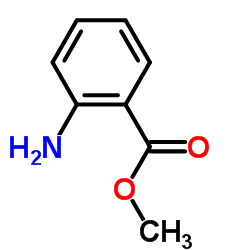Methyl 2-aminobenzoate

Methyl 2-aminobenzoate structure
|
Common Name | Methyl 2-aminobenzoate | ||
|---|---|---|---|---|
| CAS Number | 134-20-3 | Molecular Weight | 151.163 | |
| Density | 1.2±0.1 g/cm3 | Boiling Point | 256.0±0.0 °C at 760 mmHg | |
| Molecular Formula | C8H9NO2 | Melting Point | 24 °C(lit.) | |
| MSDS | Chinese USA | Flash Point | 104.4±0.0 °C | |
| Symbol |

GHS07 |
Signal Word | Warning | |
|
Palatability of bird repellents to Rattus norvegicus.
Pest Manag. Sci. 57(7) , 615-9, (2001) The palatability to captive, mostly laboratory-bred, Norway rats (Rattus norvegicus) of cereal-based baits containing 0.02 g kg-1 brodifacoum, with and without bird-repellent additives, was compared in a no-choice experimental design. Methyl anthranilate (25 ... |
|
|
Synthesis and antibacterial activity of novel 4-chloro-2-mercaptobenzenesulfonamide derivatives.
J. Enzyme Inhib. Med. Chem. 28(1) , 41-51, (2013) Few series of novel 4-chloro-2-mercaptobenzenesulfonamides have been synthesized by the reactions of N-(benzenesulfonyl)cyanamide potassium salts 7-15 with corresponding hydrazinecarbodithioic acid esters, 1-substituted carbothioic acid hydrazides, methyl 3-a... |
|
|
High-performance liquid chromatographic determination of methyl anthranilate, hydroxymethylfurfural and related compounds in honey.
J. Chromatogr. A. 917(1-2) , 95-103, (2001) A high-performance liquid chromatographic method for determining 5-hydroxymethyl-2-furaldehyde (hydroxymethylfurfural), 2-furaldehyde (furfural), furan-2-carboxylic acid (2-furoic acid), furan-3-carboxylic acid (3-furoic acid), furan-3-carboxaldehyde (3-fural... |
|
|
Comparison of methyl anthranilate and denatonium benzoate as aversants for learning in chicks.
Physiol. Behav. 70(5) , 521-5, (2000) Methyl anthranilate (MeA) has been widely used as a taste aversant for domestic chicks in the one-trial passive avoidance learning (PAL) task. However, MeA has a strong smell that may be aversive to chicks. Therefore, odourless denatonium benzoate (DB) has be... |
|
|
Reducing honey bee defensive responses and social wasp colonization with methyl anthranilate.
J. Med. Entomol. 46(4) , 782-8, (2009) Human victims of a massive number of stings have been steadily increasing since the invasion of Africanized honey bees (Apis mellifera) to the United States in 1990. Multiple honey bee stings may result in venom toxicity, leading to renal failure and even dea... |
|
|
Passive avoidance training results in increased responsiveness of voltage- and ligand-gated calcium channels in chick brain synaptoneurosomes.
Neuroscience 93(4) , 1507-14, (1999) A temporal cascade of events has been described from a number of biochemical investigations of passive avoidance training in day-old chicks. Among these, within minutes of training, there is a transient, enhanced release of glutamate and increased agonist and... |
|
|
Effects of prenatal exposure to a 50-Hz magnetic field on one-trial passive avoidance learning in 1-day-old chicks.
Bioelectromagnetics 31(2) , 150-5, (2010) We investigated memory impairment in newly hatched chicks following in ovo exposure to a 50-Hz magnetic field (MF) of 2 mT (60 min/day) on embryonic days 12-18. Isolated and paired chicks were used to test the effect of stress during training, and memory rete... |
|
|
Substrate-induced fit of the ATP binding site of cytidine monophosphate kinase from Escherichia coli: time-resolved fluorescence of 3'-anthraniloyl-2'-deoxy-ADP and molecular modeling.
Biochemistry 39(51) , 15870-8, (2000) The conformation and dynamics of the ATP binding site of cytidine monophosphate kinase from Escherichia coli (CMPK(coli)), which catalyzes specifically the phosphate exchange between ATP and CMP, was studied using the fluorescence properties of 3'-anthraniloy... |
|
|
An investigation of the inclusion complex of cyclomaltoheptaose (beta-cyclodextrin) with N-methylanthranilic acid in the solid state.
Carbohydr. Res. 344(18) , 2606-8, (2009) A 2:1 complex between cyclomaltoheptaose (beta-cyclodextrin) and N-methylanthranilic acid has been studied in the solid state. The inclusion complex belongs to the triclinic system (space group P1) with unit cell dimensions a=15.2773(15)A, b=15.4710(15)A, c=1... |
|
|
Field capture of northern and western corn rootworm beetles relative to attractant structure and volatility.
J. Chem. Ecol. 30(9) , 1809-25, (2004) We used field assays to study attraction of feral northern and western corn rootworm beetles (Diabrotica barberi and D. virgifera virgifera) to a series of mostly nitrogenous and benzenoid synthetic compounds allied with host plant and floral aromas. Vaporiza... |